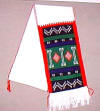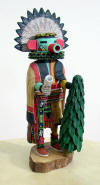
| AIS 100: Introduction to American Indian Studies |
|
| Your beautiful rays, may they color our faces; being dyed in them, somewhere at an old age we shall fall asleep old women. (Woman's prayer to sun, for a newborn girl/Hopi) |
HOPI
The Hopi see themselves as being at the center of the world and rightly so, they have been on their four mesas for well over 1000 years. They are one of the Pueblo people and represent the western most group. The choice to live in their arid environment was was made many ages ago and included a lifestyle with humble roots and hard work; both physical and spiritual. The word Hopi means 'one who follows the right path' which continues to represent an ideal goal to aspire by.
I. Origins
Hopi language, Aztec-Tanoan (Shoshonean) indicates that the core of the culture has very ancient connection to the American desert. Hopi traditions indicates a broader influence of origins from many directions, but the specifics of this diversity is lost in the past.
II. Traditional Culture
Various factors contributed to the fact that Hopi have remained in their homeland with a traditional culture relatively intact. One factor is that the place they chose was rather arid and was not coveted as much by others until Anglos discovered coal and uranium. This is the case with many desert dwellers. So traditional cultural features such as the annual Kachina cycle ceremonies are still in place throughout many of the Hopi villages. Since some changes have occurred from Hispanic and Anglo pressures we will still refer to traditional culture as pre-Hispanic. The central feature of Hopi cultures is the Kachina Cycle that lasts from the Winter Solstice (Dec 21) to the Summer Solstice (Jun 21) when ancestral spirits called Kachinas come from their cloud homes among the people in the form of dancers to renew powers of fertility and rain. The clans and phratries take on the responsibility of maintaining the kivas (sacred underground structures), altars and other sacred paraphernalia. From the Summer Solstice to the Winter Solstice non-Kachina ceremonies are conducted. In effect the Hopi have maintained a rigorous ceremonial calendar as a strategy for adapting to their desert environment.
| Hopi | < 1540 |
| Language | Aztec-Tanoan | Shoshonean | ||||||||||||||
| Settlement | 1st Mesa | Walpi,Sichomovi, Sikyatki,Polacca | ||||||||||||||
| 2nd Mesa | Sipaulovi,Mishongnovi, Shungopavi, Payupki | |||||||||||||||
| 3rd Mesa | Oraibi, Bacavi, Hotevilla, | |||||||||||||||
| Antelope Mesa | Awatovi , Kawalka, Chakpahu,Nesuftonga, Kokopnyama,Jeddito, Lululongturque | |||||||||||||||
| Economics | CBS | dry agriculture, clan owned, | ||||||||||||||
| Social | Clan, Phratry(two+ clans, Village | Matrilineal Totemic Exogamous Clans
Matrilocal/focal |
||||||||||||||
| World View | Emergence Myth
Kachina Cycle and Ceremonies |
|
||||||||||||||
| Expressed Forms | Kachina Traditions
Weaving Jewelry |
III. Contemporary Culture
Two dramatic and traumatic periods of change have taken place for the Hopi people. First was the invasion of the Spanish, who attempted to enforce labor service and religious conversion. After the Pueblo Revolt of 1680 the Spanish were removed but numerous towns, mostly on Antelope Mesa were abandoned. Some Tewa escaped Spanish revenge and were allowed to settle in Hano on First Mesa. When Anglos invaded they tried various phases of relocation and enculturation including the removal of Hopi children to government schools at Keam's Canyon.
| Hopi | > 1949 |
The Hopi continue to struggle to maintain their initial dictate of a humble and responsible lifestyle in spite of tremendous pressure from the outside society. Their real goal is to maintain their values and commitment as they respond to the many modern changes. Hopi are seen by many Native Americans and non Indians as a model of values lost to modern changes and context. Many Hopi have been educated in both Hopi traditions and non- Indian academics. Also, numerous Hopi artists have worked in various medias especially to produce jewelry, weaving, kachina carvings and ceramics.
 |
 |
 |
 |
Recently the Iraq War has brought casualties to a number of American Indian communities. In 2003, Lori Piestewa became the first Native American woman to be killed in foreign soil. Lori was Hopi/Navajo and a number of memorials have bee established for her and fund raisers have been given to her children who are being raised by their grandparents
Links to Hopi
Hopi Preservation Program at NAU
Hopi Films:
Koyaanisqaatsi (Life Out Of Balance) 1983
Itam Hakin: Hopiit 1985; Seeing With A Native Eye: A Hopi Film On Hopi
Hopi Land 2001
Copyright © S. J. Crouthamel